642
8 shocking example of what people came for the sake of "beauty"
Better to die fashion, than to live somehow - considered at all times. The sacrifices of God brought different modes: comfort, teeth, health, frogs and birds of paradise - everything was on the altar
Do not breathe
. Corset, unlike many fashion accessories, lived for centuries and has always evoked outrage feminists demanding freedoms of women, as well as her body. Especially refined its variants, dragging away not only the waist, and chest were in vogue in the XVI century in Spain: with metal or wooden bars, hinges on the sides and holes all over the body - to the air. When a corset tied up, the edges of holes cut into the body. For a modern look, this thing looks more like a torture device than on the subject of women's toilets. Then, softened conditions: whalebone was used instead of metal. But breathing from it was not easy - a fashionable standard of waist introduced Frenchwomen of the XVII century, was 33 cm To achieve ideal, pre-drinking ladies diluted vinegar and using spasms, tightened the laces
.. Despite protests from doctors who claimed that the corset facilitates deformation of the internal organs, he lived up to the middle of the last century. It was then in the Guinness Book of Records has got Ethel Granger - "the most thin waist in the world." For the sake of her husband she was ten years (from 1929 to 1939) with the help of corsets brought his waist from 24 to 13 inches - the same standard of French XVII century
.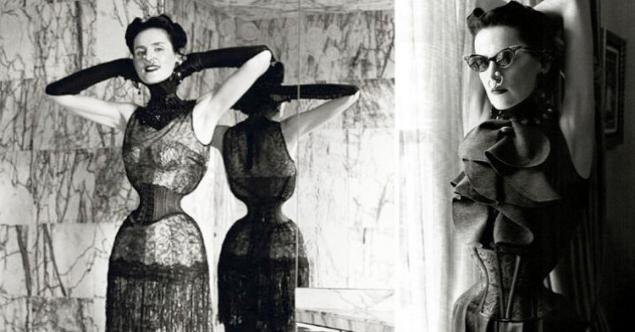
Noble consumption
"The young man with burning eyes, pale ..." - so formulated Bryusov image unmistakably to involve women in the XIX - early XX century. Painful thinness, pallor, sudden blush, feverish glitter eyes ... Despite the fact that, as a rule, is accompanied by high fever, bloody cough and early death - of consumption (so-called tuberculosis), - it is such, not bulging macho, were, according to many women, true, noble men. No wonder Lord Byron wrote: "I would like to die of consumption. All the ladies would say, "Look at poor Byron! How beautifully he dies! ».»

The deadly pallor
Even in Roman times and tan healthy glow considered prostolyudinok lot. Noble matron supposed to have alabaster skin color. The course was pounded chalk mixed with white lead, which slowly but surely poison the body. There was also effective, but no less dangerous "beauty cream": mutton fat, potato starch and tin oxide. Later, during the Renaissance, there was Mrs. Tofan powder with the addition of arsenic and double action: it is pale and herbs not only his mistress, but was a part in contact with her lawful wedded husband - so it was poisoned by some 600 men. Later, the girls helped get rid of the blush and the leeches - blood sucking excess
.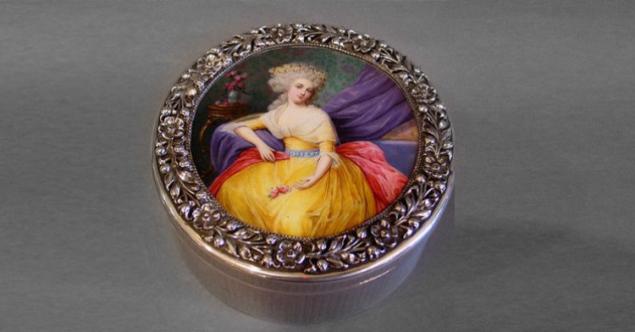
crinoline parachute instead
In the modern view, the crinoline is like a wire base of a very large lampshade. The life of this cumbersome structure, reaches the height of fashion to 2 m in diameter, it was short - approximately between the London exhibition in 1859 and the World Exhibition in Paris in 1867 - but impressive. Ladies often could not get in the door at home, not to mention the crew, but the steel bands contributed to the immense width of Compliance "modesty prescribed distance" with someone.
There were also unpredictable situations. So, in 1863, The Times newspaper reported the death of 14-year-old maid Margaret Devi, whose dress caught fire, stretched out on the fashionable design. The jury returned a verdict: "Death due to an accident caused by a crinoline." But Sarah Ann Henley Hopped after a quarrel with her lover to Clifton Suspension Bridge height 75 m, crinoline saved the life, playing the role of a parachute.
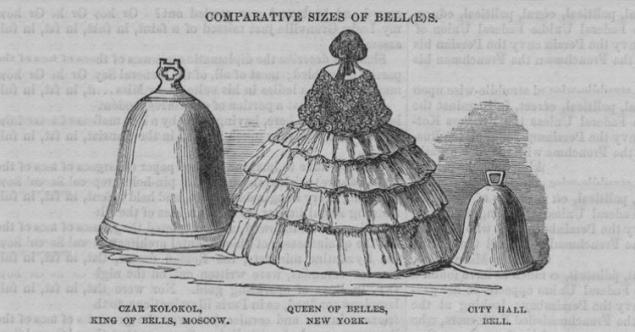
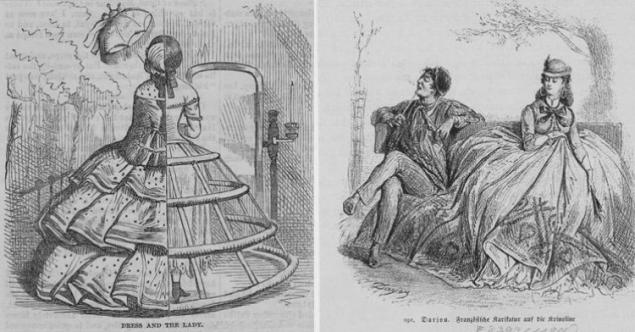
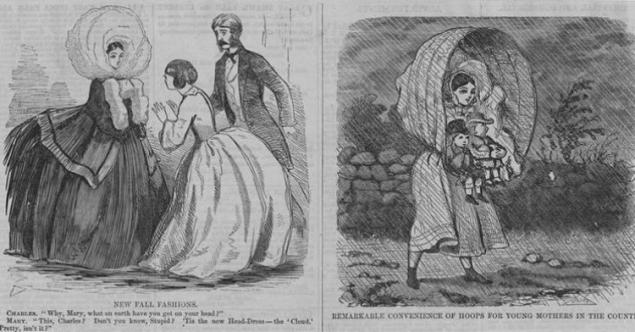
Glitter Eye and hollowness of the cheeks
To achieve brilliance with the pupils of the eyes - huge, as the Black Sea, - dripped atropine in the eye. Vision dangerously falling, but after a while returned. But the fashion of the 1930s on the sunken cheeks, which arose in the wake of Fame Marlene Dietrich, forced beauties in the extreme and irreversible action: Remove both sides of the molars
.
Emerald, full-bodied, venomous
Swedish chemist Carl Wilhelm Scheele made many discoveries. In 1775 he received the arsenic acid, which, when mixed with copper sulfate, gave a beautiful green hue. Later - with the addition of copper acetate - saturated color has become emerald green and immediately gained popularity. "Green Scheele," as it was called, became widely used - in clothing, fabrics for curtains, candles, candy wrappers, paint for walls and wallpaper, putting people at risk of death. Trendy color captured Europe: the end of the XIX century 80% of the wallpapers in England contained arsenic. The typical English climate humid environment wallpaper smelled musty and garlic. (But there was also a plus - the bugs in these areas have not lived.) It is believed that due to the poisoned wallpaper reinforced the view of the benefits of climate change for the patients. Still there was no use - people stopped etched arsenic
.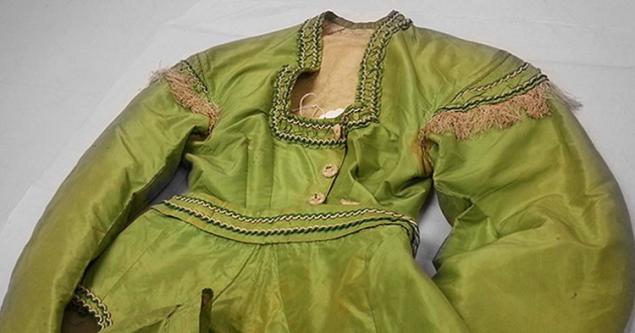
Smooth skin until death
Hair removal, practiced since ancient times and ensure a smooth skin, has always been a matter of painful and sometimes like torture. Finally, in the early twentieth century, Dr. Albert Geyser invented a device for painless hair removal - Tricho System. Women rejoiced: no torture, and hair disappear forever! Dr. Geiser did not elaborate on what happened is by X-rays - one of the types of ionizing radiation. Already in 1925 the first reports about the side effects of hair removal in the Journal of the American Medical Association - seals, ulcers and tumors. However Tricho System continued to be used until 1947, when many took advantage of the device have already died from cancer.
The entrance to hats vehicles is prohibited
Women's hats, in the days of Queen Marie Antoinette had to 1, 5 m in diameter, were a real work of art. Flower arrangements, lace, jewels, cells with birds and models of ships - all manage to fit on their heads beautiful ladies. XIX and early XX century made their additions. "The decoration of the summer millinery in Paris are now the frog, especially spectacular on a white background" - journal "Revue de la mode" wrote. In the course were stuffed birds, especially heavenly. Fashion killing - literally - two birds with one stone. The first casualty of birds and amphibians, and secondly - the young ladies, who wore on his head with ornaments in the same arsenic, taxidermists who generously used when getting your scarecrows
. In the 1900's hats, which called for the dimensions "laundry basket" were still held in high esteem. An important detail in the pins were hat - the spike about 20 cm long. Preserved judicial chronicles of the time: a woman killed by them sleeping lovers and husbands! There were excesses and unintended. "Ladies' Journal" wrote: "... in 1912 in St. Petersburg and Moscow city government in order to avoid injuries of the population has banned the ladies in hats with long pins ride in public transport»
.
Loading ... Loading ...
Liked? Share with your friends!
Loading ... Loading ...
Do not breathe
. Corset, unlike many fashion accessories, lived for centuries and has always evoked outrage feminists demanding freedoms of women, as well as her body. Especially refined its variants, dragging away not only the waist, and chest were in vogue in the XVI century in Spain: with metal or wooden bars, hinges on the sides and holes all over the body - to the air. When a corset tied up, the edges of holes cut into the body. For a modern look, this thing looks more like a torture device than on the subject of women's toilets. Then, softened conditions: whalebone was used instead of metal. But breathing from it was not easy - a fashionable standard of waist introduced Frenchwomen of the XVII century, was 33 cm To achieve ideal, pre-drinking ladies diluted vinegar and using spasms, tightened the laces
.. Despite protests from doctors who claimed that the corset facilitates deformation of the internal organs, he lived up to the middle of the last century. It was then in the Guinness Book of Records has got Ethel Granger - "the most thin waist in the world." For the sake of her husband she was ten years (from 1929 to 1939) with the help of corsets brought his waist from 24 to 13 inches - the same standard of French XVII century
.

Noble consumption
"The young man with burning eyes, pale ..." - so formulated Bryusov image unmistakably to involve women in the XIX - early XX century. Painful thinness, pallor, sudden blush, feverish glitter eyes ... Despite the fact that, as a rule, is accompanied by high fever, bloody cough and early death - of consumption (so-called tuberculosis), - it is such, not bulging macho, were, according to many women, true, noble men. No wonder Lord Byron wrote: "I would like to die of consumption. All the ladies would say, "Look at poor Byron! How beautifully he dies! ».»

The deadly pallor
Even in Roman times and tan healthy glow considered prostolyudinok lot. Noble matron supposed to have alabaster skin color. The course was pounded chalk mixed with white lead, which slowly but surely poison the body. There was also effective, but no less dangerous "beauty cream": mutton fat, potato starch and tin oxide. Later, during the Renaissance, there was Mrs. Tofan powder with the addition of arsenic and double action: it is pale and herbs not only his mistress, but was a part in contact with her lawful wedded husband - so it was poisoned by some 600 men. Later, the girls helped get rid of the blush and the leeches - blood sucking excess
.

crinoline parachute instead
In the modern view, the crinoline is like a wire base of a very large lampshade. The life of this cumbersome structure, reaches the height of fashion to 2 m in diameter, it was short - approximately between the London exhibition in 1859 and the World Exhibition in Paris in 1867 - but impressive. Ladies often could not get in the door at home, not to mention the crew, but the steel bands contributed to the immense width of Compliance "modesty prescribed distance" with someone.
There were also unpredictable situations. So, in 1863, The Times newspaper reported the death of 14-year-old maid Margaret Devi, whose dress caught fire, stretched out on the fashionable design. The jury returned a verdict: "Death due to an accident caused by a crinoline." But Sarah Ann Henley Hopped after a quarrel with her lover to Clifton Suspension Bridge height 75 m, crinoline saved the life, playing the role of a parachute.



Glitter Eye and hollowness of the cheeks
To achieve brilliance with the pupils of the eyes - huge, as the Black Sea, - dripped atropine in the eye. Vision dangerously falling, but after a while returned. But the fashion of the 1930s on the sunken cheeks, which arose in the wake of Fame Marlene Dietrich, forced beauties in the extreme and irreversible action: Remove both sides of the molars
.

Emerald, full-bodied, venomous
Swedish chemist Carl Wilhelm Scheele made many discoveries. In 1775 he received the arsenic acid, which, when mixed with copper sulfate, gave a beautiful green hue. Later - with the addition of copper acetate - saturated color has become emerald green and immediately gained popularity. "Green Scheele," as it was called, became widely used - in clothing, fabrics for curtains, candles, candy wrappers, paint for walls and wallpaper, putting people at risk of death. Trendy color captured Europe: the end of the XIX century 80% of the wallpapers in England contained arsenic. The typical English climate humid environment wallpaper smelled musty and garlic. (But there was also a plus - the bugs in these areas have not lived.) It is believed that due to the poisoned wallpaper reinforced the view of the benefits of climate change for the patients. Still there was no use - people stopped etched arsenic
.

Smooth skin until death
Hair removal, practiced since ancient times and ensure a smooth skin, has always been a matter of painful and sometimes like torture. Finally, in the early twentieth century, Dr. Albert Geyser invented a device for painless hair removal - Tricho System. Women rejoiced: no torture, and hair disappear forever! Dr. Geiser did not elaborate on what happened is by X-rays - one of the types of ionizing radiation. Already in 1925 the first reports about the side effects of hair removal in the Journal of the American Medical Association - seals, ulcers and tumors. However Tricho System continued to be used until 1947, when many took advantage of the device have already died from cancer.
The entrance to hats vehicles is prohibited
Women's hats, in the days of Queen Marie Antoinette had to 1, 5 m in diameter, were a real work of art. Flower arrangements, lace, jewels, cells with birds and models of ships - all manage to fit on their heads beautiful ladies. XIX and early XX century made their additions. "The decoration of the summer millinery in Paris are now the frog, especially spectacular on a white background" - journal "Revue de la mode" wrote. In the course were stuffed birds, especially heavenly. Fashion killing - literally - two birds with one stone. The first casualty of birds and amphibians, and secondly - the young ladies, who wore on his head with ornaments in the same arsenic, taxidermists who generously used when getting your scarecrows
. In the 1900's hats, which called for the dimensions "laundry basket" were still held in high esteem. An important detail in the pins were hat - the spike about 20 cm long. Preserved judicial chronicles of the time: a woman killed by them sleeping lovers and husbands! There were excesses and unintended. "Ladies' Journal" wrote: "... in 1912 in St. Petersburg and Moscow city government in order to avoid injuries of the population has banned the ladies in hats with long pins ride in public transport»
.

Loading ... Loading ...
Liked? Share with your friends!
Loading ... Loading ...
25+ nominees for Best First Man Title of the village
20+ people who have found ways to fight the crisis























